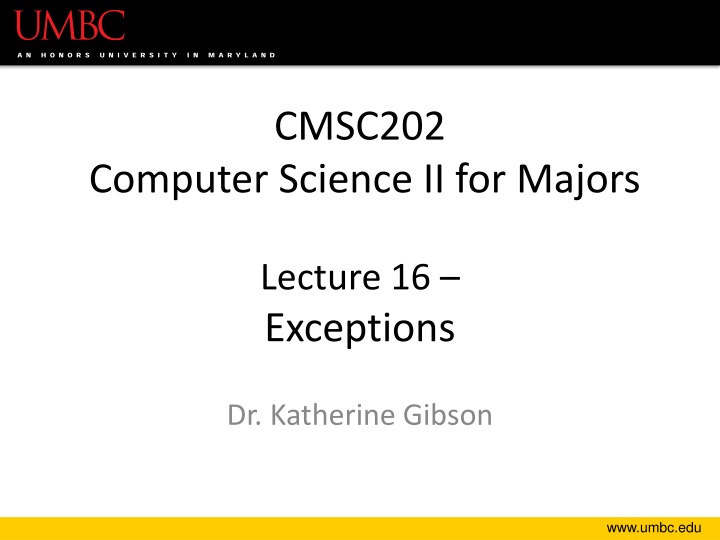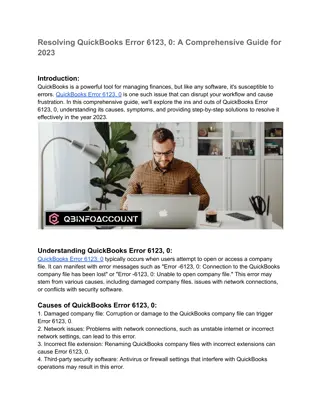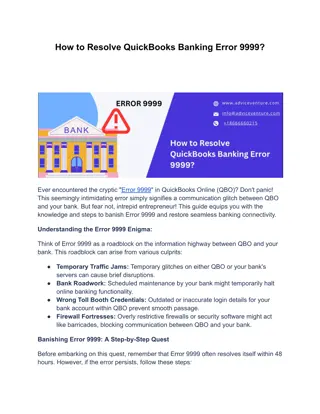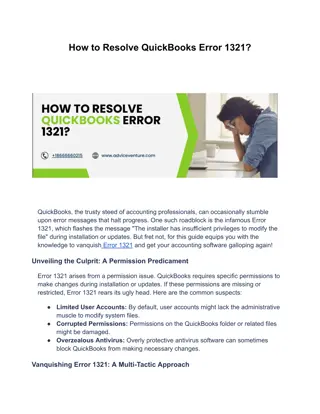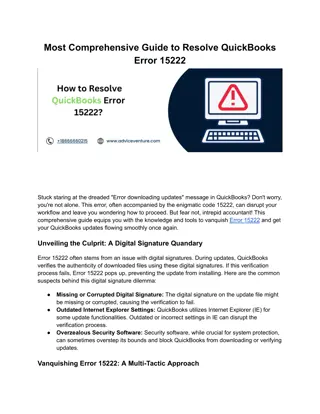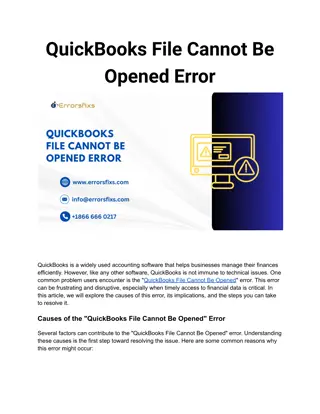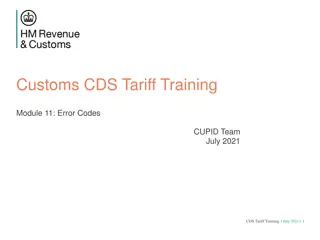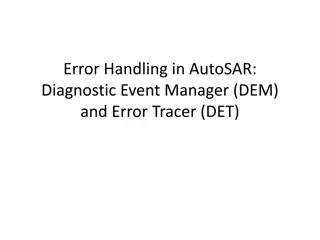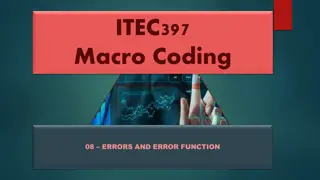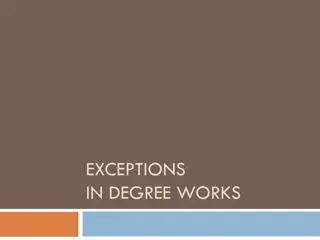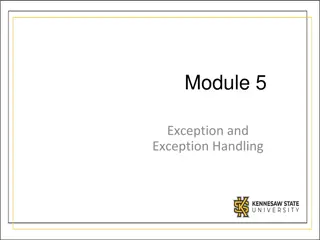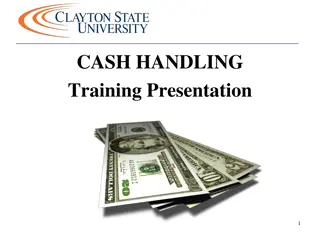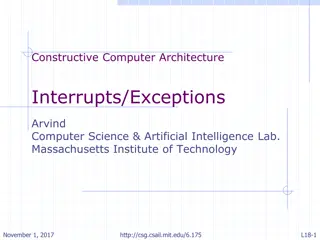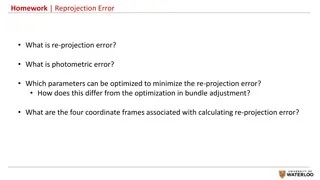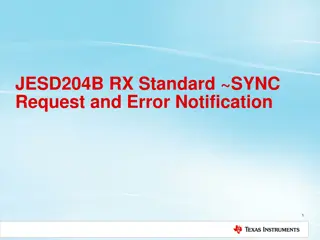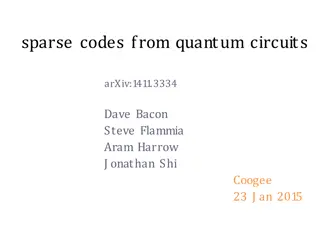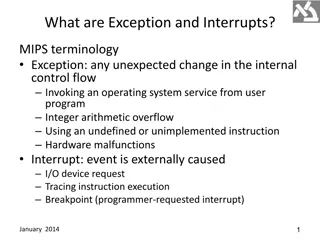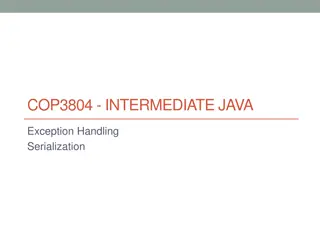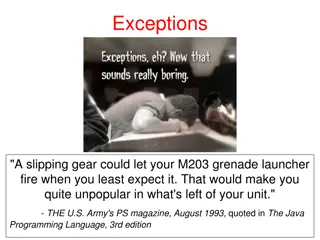CMSC202: Lecture 16 - Error Handling & Exceptions Overview
In this lecture, Dr. Katherine Gibson covers error handling, defining exception classes, utilizing exceptions like try, throw, and catch, and understanding when to throw exceptions. The session delves into common errors encountered in programming, how to handle errors effectively, and the advantages of separating error detection from error handling using exceptions. The importance of distinct roles for class implementers and users in managing errors is also highlighted.
Download Presentation

Please find below an Image/Link to download the presentation.
The content on the website is provided AS IS for your information and personal use only. It may not be sold, licensed, or shared on other websites without obtaining consent from the author.If you encounter any issues during the download, it is possible that the publisher has removed the file from their server.
You are allowed to download the files provided on this website for personal or commercial use, subject to the condition that they are used lawfully. All files are the property of their respective owners.
The content on the website is provided AS IS for your information and personal use only. It may not be sold, licensed, or shared on other websites without obtaining consent from the author.
E N D
Presentation Transcript
CMSC202 Computer Science II for Majors Lecture 16 Exceptions Dr. Katherine Gibson www.umbc.edu
Last Class We Covered Inheritance Polymorphism Virtual functions Abstract Classes Exam 2 2 www.umbc.edu
Any Questions from Last Time? www.umbc.edu
Todays Objectives Error handling Exceptions Defining exception classes Using exceptions Try Throw Catch When to throw exceptions 4 www.umbc.edu
Error Handling www.umbc.edu
Common Errors We have seen a number of error types: Could not allocate memory Out-of-bounds on vector File not found/could not be opened Attempting to add a train car that s not allowed A poker hand with invalid cards 6 www.umbc.edu
Handling Errors Now How are these errors handled? Print a message You cannot add a second Snack Car Do nothing Exit the program The errors are handled right where they occur 7 www.umbc.edu
Handling Errors at Occurence Advantages: Easy to find because code is right there Disadvantages: Error handling scattered throughout code Code duplication Code inconsistency (even worse!) Errors are handled however the original coder decided would be best 8 www.umbc.edu
Two Coders for Each Class Class implementer Creates the class definition Knows what constitutes an error Decides how to handle errors Class user Uses the class implementation Knows how they want to handle errors (But if handled internally, the class user may not even know an error occurred) 9 www.umbc.edu
Separating Errors Want to separate errors into two pieces: Error detection Implementer knows how to detect Error handling User can decide how to handle Use exceptions to do this 10 www.umbc.edu
Exceptions www.umbc.edu
Exceptional Cases Exceptions are used to handle exceptional cases Cases that shouldn t occur normally Allow us to indicate an error has occurred without explicitly handling it C++ uses these too, like when we try to use .at() to examine an out-of-bounds element 12 www.umbc.edu
Try / Throw / Catch Exceptions are implemented using the keywords try, throw, and catch 13 www.umbc.edu
Try / Throw / Catch Exceptions are implemented using the keywords try, throw, and catch The try keyword means we are going to try something, even though we are not sure it is going to perform correctly 14 www.umbc.edu
Try / Throw / Catch Exceptions are implemented using the keywords try, throw, and catch The throw keyword is used when we encounter an error Means we are going to throw two things A value (explicit) Control flow (implicit) 15 www.umbc.edu
Try / Throw / Catch Exceptions are implemented using the keywords try, throw, and catch The catch keyword means we are going to try to catch at most one type of value To catch different types of values, we need multiple catch statements 16 www.umbc.edu
Exception Example // inside SetCarID() function if (newID < MIN_ID_VAL || newID > MAX_ID_VAL) { cerr << "ID invalid, no change"; } 17 www.umbc.edu
Exception Example // inside SetCarID() function try { if (newID < MIN_ID_VAL || newID > MAX_ID_VAL) { cerr << "ID invalid, no change"; } } catch () { } 18 www.umbc.edu
Exception Example // inside SetCarID() function try { if (newID < MIN_ID_VAL || newID > MAX_ID_VAL) { throw(newID); } } catch () { } 19 www.umbc.edu
Exception Example // inside SetCarID() function try { if (newID < MIN_ID_VAL || newID > MAX_ID_VAL) { throw(newID); } } catch (int ID) { } 20 www.umbc.edu
Exception Example // inside SetCarID() function try { if (newID < MIN_ID_VAL || newID > MAX_ID_VAL) { throw(newID); } } catch (int ID) { cerr << "ID invalid, no change"; } 21 www.umbc.edu
Catching and Throwing www.umbc.edu
Using Catch The catch keyword requires: One parameter Typename (int, exception, out_of_range, etc) Name (newID, e, oor, etc.) [optional] To catch multiple types of exceptions, you need to use multiple catch blocks 23 www.umbc.edu
Using Catch You can throw from inside a catch block But this should be done sparingly and only after careful consideration Most of the time, a nested try-catch means you should re-evaluate your program design Uncaught exceptions will cause the terminate() function to be called 24 www.umbc.edu
Using Catch Catch blocks are run in order, so exceptions should be caught in order from Most specific to least specific To catch all possible exceptions, use: catch(...) (Literally use three periods as a parameter) 25 www.umbc.edu
Throwing Out of a Function We can throw exceptions without try/catch Most commonly done within functions Requires that we list possible exception types in the function prototype and definition Called a throw list 26 www.umbc.edu
Throw Lists Warn programmers that functions throw exceptions without catching them Throw lists should match up with what is thrown and not caught inside the function Otherwise, it can lead to a variety of errors, including the function unexpected() Can also have empty throw lists for clarity: int GetCarID() throw (); 27 www.umbc.edu
Throw List Syntax Functions can specify their throw lists // Throws only 1 type of exception retType funcName( params ) throw (excep); // Throws 2 types of exceptions (comma separated list) retType funcName( params ) throw (excep1, excep2); // Promises not to throw any exceptions retType funcName( params ) throw ( ); // Can throw any exceptions [backwards compatibility] retType funcName( params ); 28 www.umbc.edu
Throw List Example: Inside void SetCarID(int newID) throw (int) { if (newID < MIN_ID_VAL || newID > MAX_ID_VAL) { throw(newID); } else { m_carID = newID; } } this function might throw an integer 29 www.umbc.edu
Throw List Example: Outside v0 // inside main() train.at(0).SetCarID(-1); What will happen if we run this code? The exception won t be caught The terminate() function will be called 30 www.umbc.edu
Throw List Example: Outside v1 // inside main() try { train.at(0).SetCarID(-1); } catch (int ID) { cerr << "ID invalid, no change"; } this user has based their code on getting input from a file 31 www.umbc.edu
Throw List Example: Outside v2 // inside main() while(set == false) { try { train.at(0).SetCarID(userID); set = true; } catch (int ID) { cerr << "ID" << ID << "invalid, give another"; cin >> userID; } } this user has based their code on getting input from a user, and being able to repeat requests 32 www.umbc.edu
Exception Classes www.umbc.edu
Exception Classes We can create, throw, and catch exception classes that we have created We can even create hierarchies of exception classes using inheritance Catching the parent class will also catch all child class exceptions 34 www.umbc.edu
Exception Class Example class MathError { /*...*/ }; class DivideByZeroError: public MathError { /*...*/ }; class InvalidNegativeError: public MathError { /*...*/ }; 35 www.umbc.edu
Creating Exception Classes Name of class reflects the error Not the code that throws error Contains basic information or a message Parameter value Name of function that detected error Description of error Methods required Constructor (one or more) Accessor (one or more) 36 www.umbc.edu
Nested Functions? // function2 throws an exception void function2( ) { cout << "function2" << endl; throw int(42); } // main calls function1, // with try/catch int main( ) { try { function1( ); } catch (int) { cout << "Exception" << "occurred" << endl; } // function1 calls function2, // but with no try/catch void function1( ) { function2( ); cout << "function1" << endl; } return 0; } What happens here? Stack is unwound until something catches the exception OR until unwinding passes main What happens then? 37 www.umbc.edu
Exceptions in Constructors Best way to handle Constructor failure Replaces Zombie objects! Any sub-objects that were successfully created are destroyed (destructor is not called!) Example: // MyClass constructor MyClass::MyClass ( int value ) { m_pValue = new int(value); // pretend something bad happened throw NotConstructed( ); } www.umbc.edu
Exceptions in Destructors Bad, bad idea What if your object is being destroyed in response to another exception? Should runtime start handling your exception or the previous one? General Rule Do not throw exceptions in destructor www.umbc.edu
Announcements Project 4 is out! We ll go over Exam 2 next time 40 www.umbc.edu
